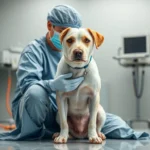
Introduction
Dog health care is a crucial aspect of responsible pet ownership, encompassing everything from routine check-ups to understanding how our furry friends contribute to our well-being. One fascinating area of study is the ability of dogs to smell sickness. This unique skill not only highlights the importance of dogs in human health but also underlines the bond we share with them.
In this article, we will explore the science behind a dog’s olfactory capabilities, the diseases they can detect, and the benefits of having a detection dog. Readers can expect to gain insights into how dogs can enhance our health care strategies and the importance of maintaining their overall well-being.
Understanding Canine Senses
Anatomy of a Dog’s Nose
To appreciate how dogs can smell sickness, we must first understand the incredible anatomy of their noses. A dog’s olfactory system consists of about 300 million scent receptors, compared to a human’s mere 6 million. This remarkable difference enables dogs to detect scents at concentrations up to 100 million times lower than humans can.
The structure of a dog’s nose includes:
- Nasal Turbinates: These are thin bones within the nasal cavity, which increase the surface area for scent detection.
- Jacobsen’s Organ: Also known as the vomeronasal organ, this structure helps dogs detect pheromones, adding another layer to their scent perception.
How Dogs Use Their Sense of Smell
Dogs utilize their acute sense of smell for various purposes. They can discern different odors and can track scents over long distances. In the context of health care, dogs are trained to identify specific scents associated with illnesses.
For instance, they play vital roles in:
- Search and Rescue: Dogs are trained to locate missing persons by following scent trails.
- Detection of Diseases: Medical detection dogs are trained to identify particular scents associated with diseases such as cancer or diabetes.
The Science Behind Dogs Sensing Sickness
Research Studies
Numerous scientific studies have demonstrated the ability of dogs to detect diseases. One pivotal study published in the journal Cancer found that dogs could identify breast cancer in samples of breath and urine with a high degree of accuracy. Other research suggests that dogs can detect diabetes by sensing changes in a person’s breath or skin.
These studies reveal that dogs can identify specific volatile organic compounds (VOCs) emitted by sick individuals, allowing them to distinguish between healthy and diseased states.
Mechanisms of Scent Detection
The ability of dogs to smell sickness can be attributed to their sensitivity to volatile organic compounds (VOCs). These compounds are chemicals released by the body due to various metabolic processes, particularly when a person is ill.
Dogs are adept at differentiating between healthy and diseased scents. For example, cancer cells can produce unique VOCs that dogs can learn to recognize through training. Through this process, dogs can alert their owners or handlers to potential health issues.
Common Diseases Dogs Can Detect
Cancer
Dogs have shown promise in detecting various types of cancer, including:
- Lung Cancer
- Breast Cancer
- Prostate Cancer
Several anecdotal cases highlight the remarkable ability of dogs to sense these conditions before they are diagnosed through traditional medical methods. For instance, there are stories of dogs alerting their owners to breast cancer by persistently sniffing or lying near the affected area.
Diabetes
Diabetes detection is another significant area where dogs excel. They can sense changes in blood sugar levels, alerting their owners when they are too high or too low. This ability can be life-saving, as timely intervention can prevent serious complications.
Other Medical Conditions
Beyond cancer and diabetes, dogs can also detect other medical conditions, such as:
- Infections: Dogs can sense bacterial infections by detecting specific scents.
- Seizures: Some dogs can predict seizures in their owners, providing crucial alerts.
Training Dogs for Medical Detection
Overview of Training Techniques
Training dogs for medical detection involves a systematic approach that focuses on scent recognition. The basic principles include:
- Positive Reinforcement: Rewarding dogs for successfully identifying a target scent encourages them to continue honing their skills.
- Scent Discrimination: Dogs are trained to differentiate between various scents, allowing them to recognize specific markers associated with diseases.
Specialized Programs and Organizations
Many organizations specialize in training dogs for medical detection. These programs often involve rigorous training and assessment processes. For instance, medical alert dogs undergo comprehensive training to ensure they can reliably alert their handlers to changes in their health status.
Certification processes are crucial for ensuring that detection dogs meet specific standards and can perform their tasks effectively. This includes evaluating their ability to identify target scents accurately and their behavior in various situations.
Benefits of Having a Scent Detection Dog
Health Monitoring
Having a detection dog can significantly enhance ongoing health monitoring. These dogs can alert their owners to potential health issues before they become critical, allowing for timely medical intervention. This proactive approach can lead to better health outcomes.
Emotional Support
Detection dogs also provide emotional support. The bond between a dog and its owner can alleviate anxiety and stress, contributing positively to mental health. This companionship can be invaluable for individuals managing chronic health conditions.
Cost-Effectiveness
Investing in a medical detection dog can be cost-effective in the long run. Early detection of diseases can lead to timely treatment, potentially reducing the need for extensive medical interventions and hospitalizations, which can be financially burdensome.
Caring for Your Dog’s Health
Regular Vet Check-ups
Routine veterinary care is essential for maintaining a dog’s overall health. Regular check-ups can help prevent potential health issues, ensuring that any concerns are addressed promptly.
Nutrition and Exercise
A balanced diet and regular exercise are vital components of dog health care. Providing high-quality food tailored to a dog’s specific needs, along with consistent physical activity, helps maintain a healthy weight and supports overall well-being.
Mental Stimulation
Mental stimulation is as crucial as physical activity for dogs. Engaging them in interactive play, puzzle toys, and training exercises can help keep their minds sharp and prevent behavioral issues.
Myths and Misconceptions about Dogs and Sickness Detection
Debunking Common Myths
There are several myths surrounding dogs’ ability to smell sickness. One common misconception is that all dogs can naturally detect diseases without training. While some dogs may have an innate talent, training is essential for reliable detection.
Understanding Limitations
It’s important to understand the limitations of dogs in medical detection. While they can be incredibly accurate, they are not infallible. Factors such as environmental distractions, health conditions, or inadequate training can affect their performance.
Conclusion
In summary, dogs possess extraordinary capabilities that allow them to smell sickness, making them invaluable companions in health care. Their ability to detect diseases, coupled with the emotional support they provide, underscores the importance of proper health care for both dogs and their human companions. By understanding how to care for our dogs and potentially train them for medical detection, we can enhance our health while enriching the lives of our furry friends.
As we continue to explore the remarkable bond between humans and dogs, it is essential to prioritize their health and the unique contributions they can make to our lives.









